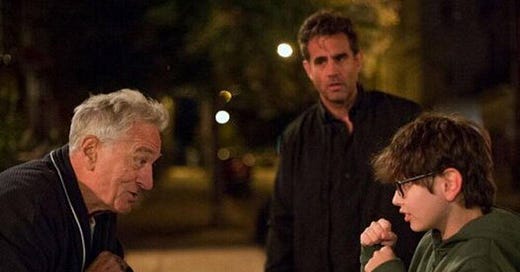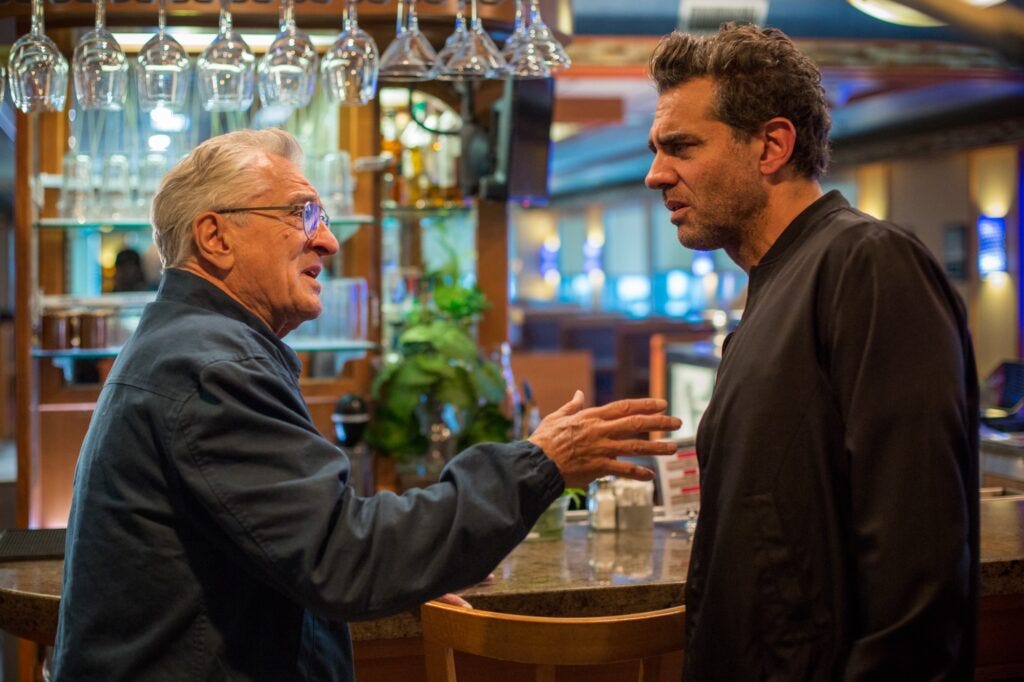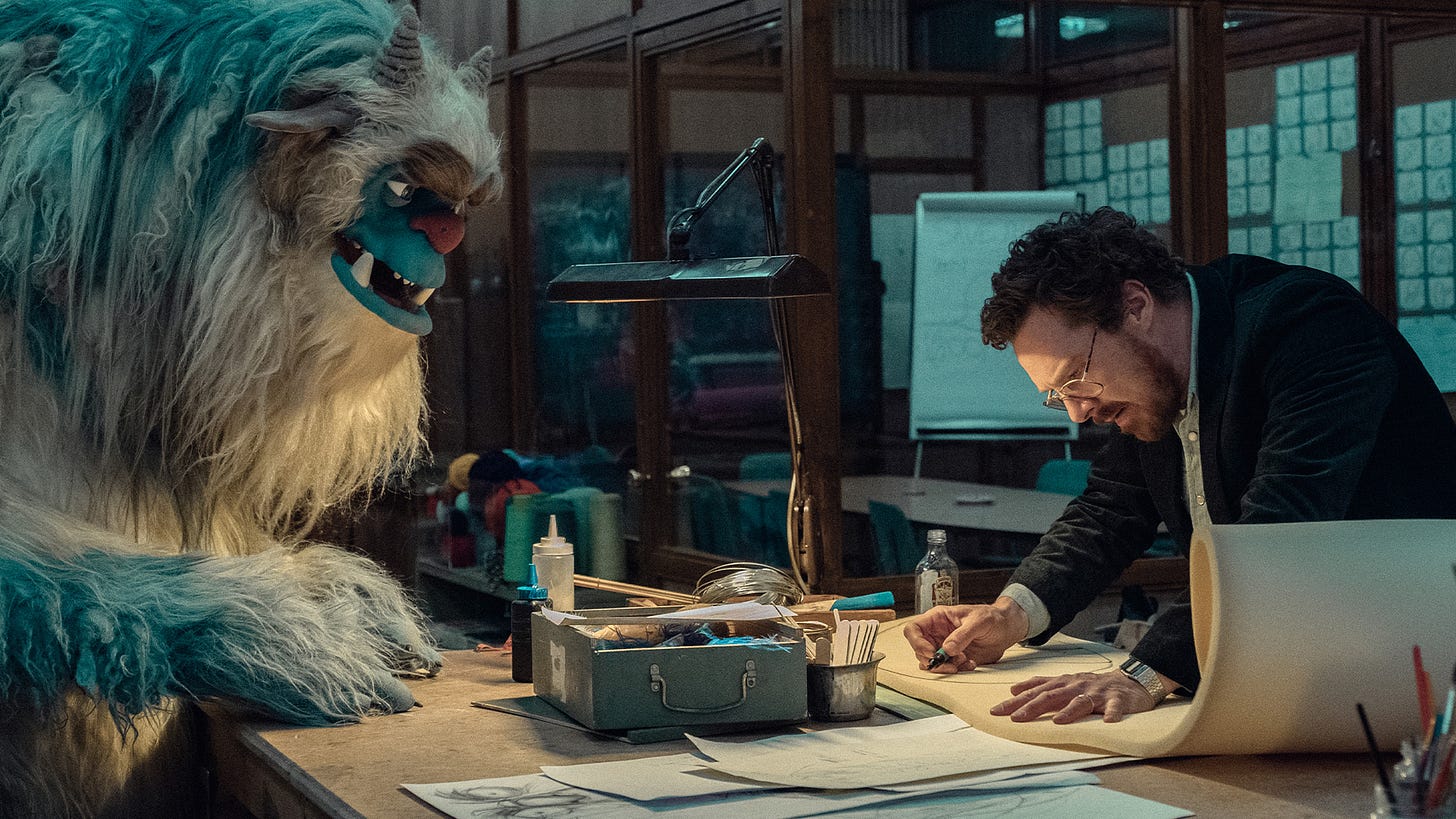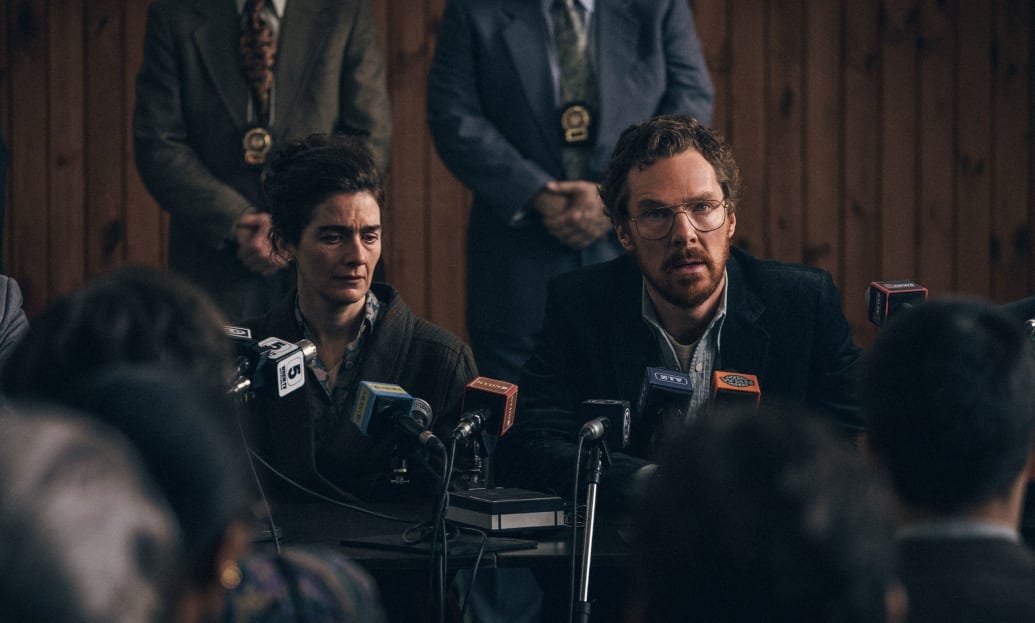Ezra (2023); TV: Eric (2024)
A moving look at an autistic boy; a deplorable exploitation of a lost one
Bonding: Stan (Robert De Niro), Max (Bobby Cannavale) and Ezra (William A. Fitzgerald)
Ezra (2023)
In theaters
This story about a special needs child smartly signposts those three words. They’re flashing red lights.
Special. Ezra (William A. Fitzgerald) is a young adolescent struggling with ASD (autism spectrum disorder). Like many autistic children, he’s often emotionally withdrawn. He can lapse into a body-shaking seizure with the slightest provocation – for Ezra it’s the mere sight of a banana.
And he yelps, wails and roars his emotional pain in public, impulsively. If his body sways and his eyes roll back, anyone might be called upon to catch him when he falls.
Needs. Ezra’s parents Max (Bobby Cannavale) and Jenna (Rose Byrne) love their son, but their tempestuous marriage has them sharply divided over the proper care for him. Max is a stand-up comedian still looking for his big break, so a nervous iconoclasm threads through every fight he picks.
He demands Ezra not be zombified with numbing drugs. Jenna believes doctors know best and wants Ezra placed in a renowned autism treatment facility.
Child. Ezra is a child, but everyone was a child once, and Max, unable to find steady employment, lives in Hoboken, NJ with his irascible father Stan (Robert De Niro). Stan wants to end Max’s childish dependence on him.
Neither man understands that their father-son shouting matches are traumatizing Ezra, aggravating his autism. The link from grandfather to adult son to vulnerable child forms a straight line. Festering rage keeps it strung tight.
Or, in this wildly funny yet moving conflation of bad parenting and good intentions, their separate frustrations just might be binding them together.
After Ezra dashes into the street to avoid an aggressive dog, he gets bumped by a cab. He wakes up, thankfully unharmed, in the hospital. To prevent such mishaps, doctors want to give Ezra antipsychotic drugs.
Max is having none of that, and, borrowing – no, stealing – Stan’s car, he hits the road with Ezra. Heading he knows not where.
When they stop over to stay with a friend, Max receives a supportive phone call from his agent (Whoopi Goldberg) that could give his career a major boost. Jimmy Kimmel is offering Max a spot on his show, but he’ll need to be in L.A. by next Friday. Max still refuses to return Ezra, so they take off for the West Coast.
Meanwhile, Jenna and Stan have issued an Amber Alert for the boy, and Max, seeing it on television, now knows he’s on the run from the authorities. Jenna and Stan take to the road to catch up with the fugitive father and son. Any chance this family will catch onto itself?
What keeps us hoping, giving the movie its frolicsome charm, is the mislaid truth that there are no bad intentions here, only scared people acting rashly.
Ezra’s isolation and pain have turned him into a self-protective boy-man, maturing in some ways faster than his father.
And headlong, hardheaded Max won’t get realistic about Ezra’s medical needs. The boy is hostage to his father’s tattered dreams. Which Max won’t understand until Stan forces his boy-man son — Max — to see that his imperfect father has always loved him.
Director Tony Goldwyn seems to have been both firm and gentle with his actors. Their line readings are rapid and taut, which suggests a calm, clear directorial discipline.
Yet all four characters’ frightened sincerity means they let loose and howl uncontrollably, so Goldwyn must have also urged the actors to hold nothing back.
The loose-limbed result, built on a script by Tony Spiridakis (whose son is on the ASD spectrum), nicely interweaves comedy and pain.
Father-son faceoff: Stan (Robert De Niro) reaching out to Max (Bobby Cannavale)
Cannavale is even better here than he was opposite another vain, slippery father, played by Al Pacino, in Danny Collins (2015).
In Max’s nightclub scenes Cannavale gets a stand-up comic’s double-edged rhythms just right. Max is breezy and anarchic, also a little scary. Picture Lenny Bruce with a special needs kid. Can we get a social worker in here, like now, please?
De Niro has played curmudgeonly fathers for some years now, and at first it seems we’ll get nothing new from him. But when he catches up with runaway Max, he realizes that Max is escaping him — Stan — not just fleeing to save Ezra from being institutionalized.
And Max is now trying to do for Ezra what Stan failed to do for him, namely, give him unconditional hugs and a sympathetic ear. Simple but not easy. A special need.
Byrne’s Jenna is passionately protective of Ezra. But in battling her erratic husband for control of Ezra she realizes they’ve got to stay a family. Only that way will Ezra finally get more room to breathe and be himself.
Fitzgerald as Ezra gives the most free-floating performance. His weirdly detached line deliveries often come at precisely the moment when autism suddenly flings Ezra’s body out of control.
The young actor never lets us lose our sympathy for this frightened boy, surrounded by adults won’t put his needs ahead of their own.
It’s a standout performance because Fitzgerald has to take us to the exact, inexplicable place where Ezra edgily gets by, unable to find words for the trembling adolescent he can’t help being.
Ezra is the movie’s marvel, its hero, because by the end we know he’s going to have to endure what neither meds nor love can remedy.
Uniqueness. He may be able to stop shaking, but he’ll have to go on figuring out himself. There’s no pill for that. It’s the special need he and the three haywire adults around him so rockily share.
TV: Eric (2024)
Streaming on Netflix, 6 episodes
Vincent (Benedict Cumberbatch, r.) with the surreal puppet only he can see and hear
I have personal feelings about this series because it’s patterned after true events that happened very close to where I reside. In 1979 I lived (and still live) in Greenwich Village, seven blocks from Prince Street in the Soho district of lower Manhattan.
On May 25 of that year Etan Patz, aged 6, walked alone from his parents’ Prince Street apartment to his school bus stop three blocks away. He never made it to the bus and hasn’t been seen since.
His disappearance stunned New York City and hit especially hard in nearby neighborhoods.
It didn’t seem unlikely that any of us who lived or worked nearby might have brushed by Etan in our daily routines. It followed – quite irrationally – that if we’d spotted him on that crucial morning, we might have stopped his abductors.
As the event transpired, of course, no one did, and residents and shopkeepers were shocked and felt deep sympathy for Etan’s parents. His disappearance was worried over for months among my neighbors, in stores and restaurants, even on the streets, where missing-child posters of Etan’s face appeared everywhere.
So, yes, even after all these years, I take it very much amiss that such a wrenching true story would be reduced to this bloated, crude “re-imagining”, or whatever the hell its creators are palming it off as.
The series’ creator-writer Abi Morgan has written smartly and sensitively for the big screen (The Iron Lady (2011), Suffragette (2015)). But here, granted a dangerously tempting six episodes of TV series “freedom”, she loads this poignant story with enough gimmicks and subplots to snuff out any pathos I might have felt.
In this macabre telling, set in 1980, eight-year-old Edgar (Ivan Morris Howe) is abducted walking alone to his school bus. His disappearance sets off strange reactions in his father Vincent (Benedict Cumberbatch), a puppeteer who’s created a hit national kids TV show.
The sensitive Edgar had imagined a “monster” under his bed he named Eric. The police say the boy has been kidnapped, i.e., by definition, held against his will.
Yet, believing he can convince Edgar to “come home”, Vincent builds first a puppet then a 7-foot furry bodysuit with a wild-eyed grimace he names Eric, and puts his creation on the air.
Climbing inside the bodysuit, Vincent, speaking to the TV camera as Eric, urges Edgar to return home. How, you might wonder, would a kidnapped child be able to do that? But no one says as much to the increasingly unhinged Vincent.
When his gambit doesn’t work, Vincent sets off to find his son. Amplifying this preposterous inventing, Morgan’s script splits into bewildering tangents. One angle is surreal. Eric comes to life, walking alongside Vincent but visible to and heard by no one else.
I was baffled and irritated. But Morgan’s writing keeps throwing us out of the harrowing story of the real Etan Patz’ tragedy to concoct feeble, ugly contrivances.
Vincent’s marriage to Cassie (Gaby Hoffman), already acrimonious, shatters under their shared parental strain.
Their struggle to keep hope alive could be compelling, but Morgan’s script doesn’t stick to a single plot line. For reasons I couldn’t understand, she makes a Black detective investigating the case (McKinley Belcher III) gay and closeted. Why?
Because his contacts in the gay underground lead him to a long-running child sex ring that could have abducted Edgar. Pile on more distraction: we learn that closeted high ranking city officials secretly patronized this child sex ring. Why not go all out horrid? Show us another missing child, this one forced into male-male prostitution, being kicked to death.
Morgan must know that such ghastly police procedural coverups have by now become stale cliches in crime storytelling, in novels and on screen. Yet her script doesn’t even try to give them a fresh spin.
This sordid mingling of secrets and sleaze becomes so crisscrossed and poorly motivated that I lost hold of what’s supposed to grip us, the fate of a child in jeopardy.
Cassie (Gaby Hoffman) and Vincent appear on television to plead for their missing son
Cumberbatch struggles conscientiously with the increasingly crazed Vincent and in moments the actor’s minutely detailed work almost stirs some honest commiseration. Almost. I never could figure out the root cause of this flailing man’s grief and self-loathing. (Introducing his cold upper-class parents explains nothing.)
Hoffman is fine as Cassie, frantically passing out leaflets on the street and pressing the police to keep looking. But her bewilderment and rage at Vincent losing his grasp on reality I could only share, not empathize with.
The actress succeeds in portraying an anguished mother, but I never felt the connection, which we see shattered, that she and Vincent had in the first place.
This series is a gaudy, depressing mess. None of its wallowing in depravity is illuminating.
Frustratingly, one component deserves high praise. The production designers’ work is outstanding. The grime and danger of 1980 New York City has been meticulously researched. They get the feverish, choked Manhattan grit of the period exactly right.
But throughout I found the grungy nightclubs and back alleys, and the intricately recreated graffiti, more teeming with wicked, bursting life than the bombast the actors were trying to get me to buy into.
All this aimless turmoil is hurled at us when a heartbreaking story was right in front of this series’ creators, crying out for a compassionate re-telling.
In real life the case of Etan’s disappearance dragged on for decades. In the ’90s after a lengthy investigation a possible suspect finally couldn’t be charged. In 2012 a man confessed to killing the boy, survived a mistrial, but was convicted in 2017 and sentenced to life in prison.
Etan had been officially declared dead in 2001. His body was never found.
That tangled web of fate, the slow gathering of conclusive evidence and years of parental longing should have been the anguished fount of honoring Etan’s tragic end. This lurid, misbegotten cartoon of a “dramatization” is a grotesque insult to a precious lost life.







